The Secret of Gobekli Tepe: Cosmic Equinox and Sacred Marriage - Part 1
Göbeklitepe is an ancient and significant site which has been pushing back the beginnings of civilization further than we previously assumed. As each temple at the Neolithic site is excavated, the story of human history is rewritten.
Göbeklitepe is situated in the city of Şanlıurfa (or Urfa) Turkey and it stands out as one of the most interesting prehistoric archaeological sites today. As a result of scientific research, Göbeklitepe temples have been dated to 9600 B.C., at the earliest - in archaeological language it’s regarded as Pre-pottery Neolithic A.
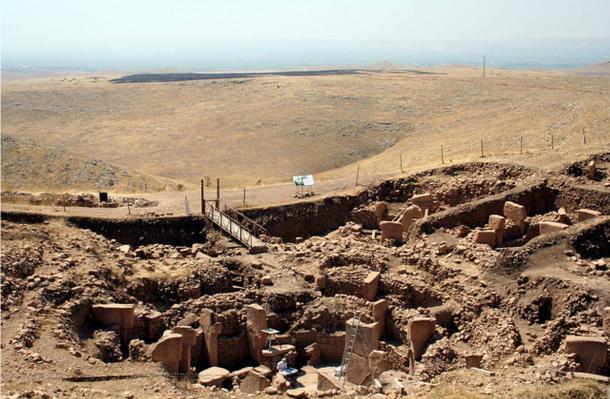
The Göbeklitepe excavation site in Turkey. Yepyep/Flickr
During the construction of Göbeklitepe there was no civilization as we know it, as there was in Sumer or Egypt. The discovery of Göbeklitepe caused a paradigm shift of archaeology: religion was evident before the advent of agriculture and permanent settlement, not after, as it was thought.
German archaeologist Klaus Schmidt, head of excavations at the ancient site, Göbeklitepe may have played an influential role in the subsequent civilizations, just as Sumer and Egypt had [8].
Could the origins of Sumerian and Egyptian gods and goddesses be found here, in Göbeklitepe?
MORE
- Excavations reveal Gobekli Tepe had oldest known sculptural workshop
- The Forgotten Stones of Karahan Tepe, Turkey
- Göbekli Tepe & The Great Year
- World's oldest temple, Göbekli Tepe, built to worship Sirius?
Göbeklitepe hosts numerous circular and square shaped temples. Klaus Schmidt and other scientists claimed that these structures could be used to perform rituals and cultic beliefs, and it’s likely that Neolithic shamans headed the rituals held in these mysterious temples [8].
Six structures have been unearthed as a result of excavations since the beginning of the 1995 season. As of 2015, multiple structures are still being revealed. Temples were identified as A, B, C, D etc.
Common threads connecting the temples are two T-shaped pillars located in the center of the temples, with 10 or 12 pillars surrounding it. The heights of the pillars vary between 3 and 6 meters (10 and 20 feet). These T-shaped pillars can be found not only in Göbeklitepe, but also in other nearby Neolithic settlements like Nevali Çori, Hamzan Tepe, Sefer Tepe and Karahan Tepe.
Almost all pillars residing in Göbeklitepe have various animal reliefs on them, depicting the snake, fox, crane, boar and other assorted creatures. The reliefs show us a quite sophisticated sense of art. Besides the various animal sculptures, totem poles and signed tablets were also unearthed.
We see also ambiguous symbols on some pillars. In addition to “”H” and “I” symbols, several sun and moon symbols were found engraved on some pillars, revealed Schmidt. The sun and moon signs which were engraved on the Temple D center pillars are quite remarkable. The moon is depicted as crescent, and the sun is portrayed with a cavity in its center. Some of these symbols will undoubtedly be vital to solving the secrets of Göbeklitepe.
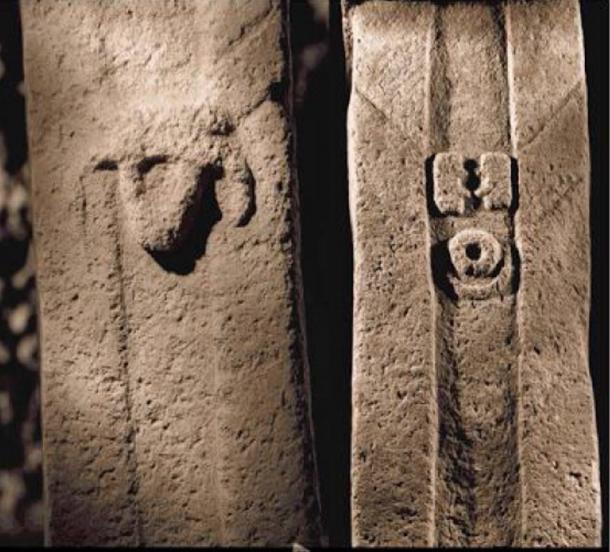
Many of the pillars at Göbeklitepe are engraved with symbols.
The astronomical meanings of these symbols is not controversial. With regard to their positions in the sky, the meaning of these symbols are likely to have cosmic or celestial significance. Perhaps Göbeklitepe temples were built as observatories for the purpose of observing celestial objects like planets and constellations.
Italian archaeoastronomer Giuglio Magli from Milano Polytechnical University propounds that Göbeklitepe temples may have been built for observing Sirius, the brightest star in night sky. According to Magli, the Göbeklitepe community might have celebrated the birth of this new bright star.
Likewise, another astronomer, B. G. Sidharth expresses that 12 pillars located around the center of Temple D could symbolize the 12 months of the year. Sidharth also thinks the “H” sign on one of the center pillars symbolizes the Orion constellation. He believes the sun and moon signs imply a solar eclipse [4]. According to Schmidt, however, the H-like sign characterizes the male and female relationship [8]. When examined closely, it does seem a kind of relationship between two individuals: both thrusting out their hands to one another.
Furthermore, Joe Plegge emphasizes that the holed stone in Temple D might have been designed for determining equinox and solstice days. He examines this theory in his book “ Turkish Stonehenge: Göbeklitepe” [7].
MORE
- Enigmatic symbols and carvings in man-made cave in England confound experts
- The sacred symbol of the Djed pillar
- Unknown ancient god with astral symbols discovered on stele at cult site in Turkey
The center pillars which depict the “H” and sun-moon signs stylize the human body, as it is generally accepted. Arms and hands can be seen precisely. Human faces are not clear. It might be that they are not humans, but gods or goddesses of the Neolithic. We see arms bestride both sides of the pillar, and the hands come together on omphalos, or navel. This standing position might be considered special and perhaps sacred. Sumerian goddess Inanna was characterized in a standing position just like center pillars of Göbeklitepe. Likewise, huge statues of Easter Islands were constructed in this kind of sacred standing position (hands on omphalos). According to some, this posture symbolizes “birth” or “rebirth”.
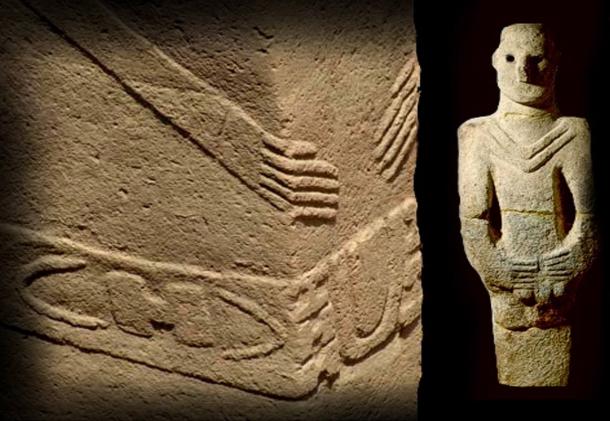
Hands are carved into the pillars, coming together in the area of the navel, like many other statuettes and figures found around the world.
Sun and moon symbols are not seen only on the center pillars of Temple D of Göbeklitepe. Later in history we see these signs on Sumerian and Akkadian cylinder seals and on other ancient artworks.
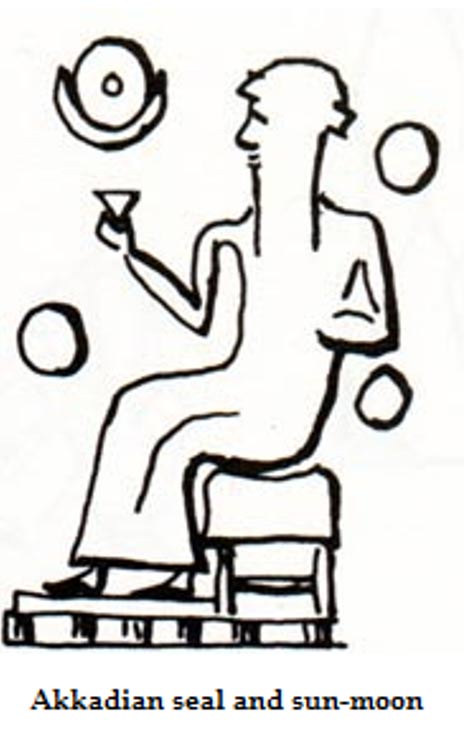
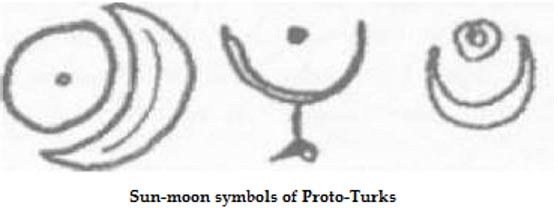
According to historian Emel Esin, Proto-Turks once named this symbol as “ Kün-ay (Sun-moon)” [3]. Kün-ay has a sacred meaning in Proto-Turkish culture. Emel Esin clarifies that this Kün-ay was the sign of the first crescent day: the first day of the first month of spring. At the same time, naturally it symbolizes the equinox day of spring, 21 of March. On that day, daytime and nighttime are of approximately equal duration. On the equinox Proto-Turks - and still modern Turks –celebrated the coming of spring, in a sense an awakening of nature, and the rebirth of earth. In this period, the fertility and of earth would increase, and soil would give plenty of produce.
Emel Esin also emphasizes that Chu Turks were using this symbol on their state flag circa 2000 B.C. in Middle Asia. According to Esin, Kün-ay sign is the origin of modern-day Turkish Republic state flag with crescent and star [3]. Kün-ay sign has been found in artworks of Hun Turks. Additionally, we see Kün-ay and crescent-star motifs on Gokturk state coins. In modern-day Mongolia (an old Proto-Turkish region) the state flag features two pillars and Kün-Ay sign.
Proto-Turkish Kün-Ay and Göbeklitepe's sun-moon signs are not just similar: they are exactly same! On both symbols, we see a cavity at the center of sun symbol. This is such a commonly repeated description that we can't say it is a coincidence. According to Emel Esin, the cavity at the center signifies the luminous side of nature [3]. It describes coming of spring, it describes rebirth of nature, and fertility as well.
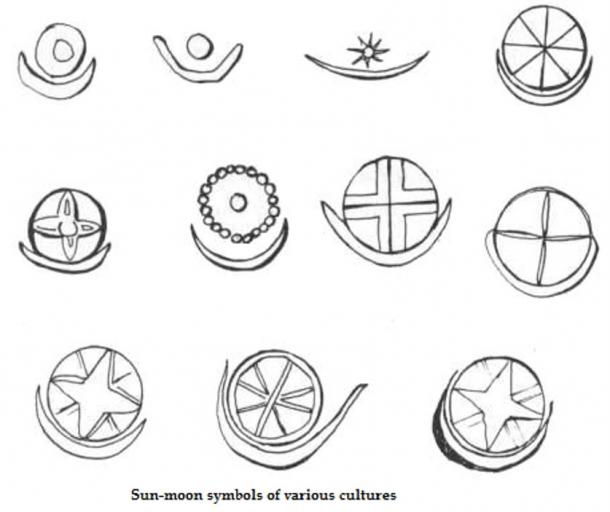
Dr. Cathy Burns refers to the crescent-star motif as a “fertility symbol” in her study “ The Hidden Secrets Of The Eastern Star” [1]. Similar crescent-star motifs can be seen on Aphrodite temple images, and on ancient Cyprus coins. As it is well known, Aphrodite was the Greek goddess of love, beauty, procreation and fertility. In Greek mythology, she is corresponded with the Sumerian goddess Inanna. Additionally, one of the symbols of Inanna was also the crescent-star. Hitittes saw this as a sign of rebirth. Lakota Indians used the crescent-star symbol for defining the solar eclipse.
B. G. Sidharth's comment about sun-moon images relates, in that he believes the sun-moon symbols found on the center pillar in Temple D describes a solar eclipse.
It is likely that the crescent-star sign then symbolizes rebirth of nature. If so, the sun-moon motif on the Göbeklitepe pillar might also symbolize the beginning of spring, time of the equinox, and rebirth of nature and earth.
[…]
Göbeklitepe, one of the most important archaeological discoveries of our time, continues to defy explanation, but further research into what might be the first temple in the world made by man, may reveal more about Neolithic understanding, and may deliver a message to us from the ancient past.
Read Part II of The Secret of Gobekli Tepe: Cosmic Equinox and Sacred Marriage.
Featured Image: Archaeological site of Göbeklitepe in Turkey. Wikimedia Commons
Images provided by Özgür Etli.
References
[1] Burns, C., “ The Hidden Secrets Of The Eastern Star”, 1994.
[2] Çığ, M. İ., “ İnanna'nın Aşkı: Sumer'de İnanç ve Kutsal Evlenme”, 9th ed., Istanbul, 2014.
[3] Esin, E., “ Türk Kozmolojisi'ne Giriş”, Istanbul, 2001.
[4] Etli, Ö. B., “ Dünyanın İlk Gözlemevi: Göbeklitepe Tapınağı”, Popüler Bilim Journal, Vol: 229, 2014.
[5] Halikarnas Balıkçısı, “ Altıncı Kıta Akdeniz”, 5th ed., Ankara, 2007.
[6] Halikarnas Balıkçısı, “ Anadolu Tanrıları”, 10th ed., Ankara, 2010.
[7] Plegge, J., “Turkish Stonehenge: Göbeklitepe”, 2012.
[8] Schmidt, K., “ Göbekli Tepe: En Eski Tapınağı Yapanlar”, Istanbul, 2006.
















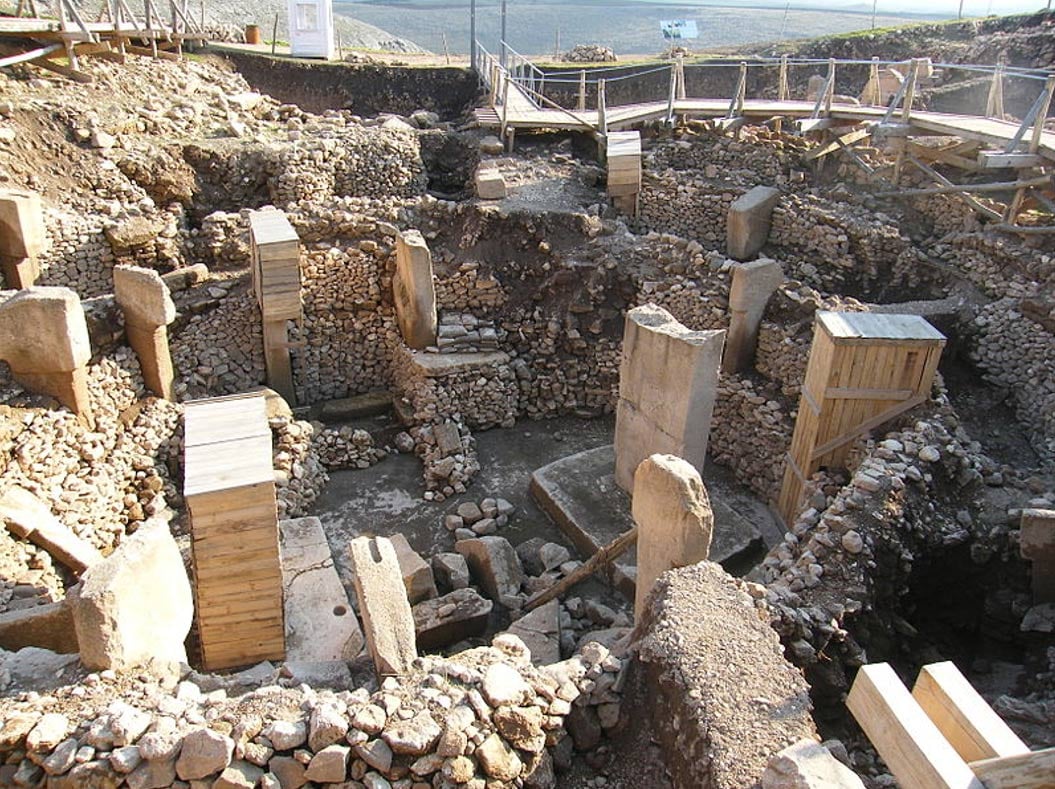

Comments
DNA markers should help distinguish population migration routes to better understand who built the oldest Neolithic temples so as to prevent cultural identity theft and misappropriation through wild speculations. Armenian cultural identity theft is a prime example that can benefit from such projects. First, according to National Geographic Genographic Project tracing human migrations, Armenians and their DNA markers were in the so-called Anatolian region more accurately the Western Armenian Highlands 80,000 to 40,000 years ago. Secondly, National Geographic's DNA results debunk any claims that Portasar is anything other than Armenian in origin. Thirdly, according to National Geographic Genographic Project, Armenian DNA through the Y chromosome has a direct link to Pharaoh Akhenaten and his son King Tut; thus, directly linked to all the Pharaohs of Egypt, which proves that Armenians were the progenitors of Ancient Egypt. Yet, most British museums hold out ancient Armenian artifacts of gods and goddesses as derived from "Ancient Turkey" without mentioning the Armenian origins because of pressures from the Turkish government. Clearly, there was no Ancient Turkey as it is a country only 100 years old.
And no, Armenians don't hold themselves out to be space alien hybrids as some have proposed about Akhenaten from shows like "Ancient Aliens" but are indeed a unique human species separate and apart and far more evolved genetically than other current human species on the planet. I think the Armenians should have a new name for their distinct and more evolved species from the rest of the hominids left on the planet.
I see that this article has TRIGGERED you.
The site was NOT built by "Proto-Turks." The Turkish invaders did not conquer Anatolia until the Middle Ages. They are Central Asian invaders who came very LATE to this region. Before them, Anatolia was inhabited by Lydians, Hittites, Armenians, and other people.
The sun and moon on the Turkish flag are Islamic symbols as any fool knows. This article is offensive, revisionist, racist trash and propaganda.
Kun’Ay phonetically is similar to the Tibetan snake-eating Khyung, which is a creature made from a bull and a bird, which is a representation of the North Pole stars, and the precession Circle. Historically these two regions are linked with the three way war in`Tibet between a Turkic group, India and China
I believe there are numerous linear patterns drawn on the pillars. I would like to see if they align to the same astronomical value desribed in my book….
Enigmatic Lines
possibly those symbols are plasma dischares between the planets give symbols of an alien sky a look into https://youtu.be/t7EAlTcZFwY
Pages